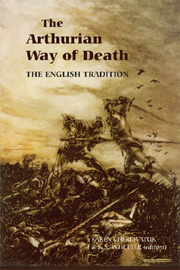Book contents
- Frontmatter
- Contents
- Illustrations and Tables
- Dedication
- List of Contributors
- Introduction
- Part I The early Tradition in england
- Part II Middle English Romance and Malory
- 4 ‘Hadet with an aluisch mon’ and ‘britned to noℨt’: Sir Gawain and the Green Knight, Death, and the Devil
- 5 Love and Death in Arthurian Romance
- 6 Death in the Margins: Dying and Scribal Performance in the Winchester Manuscript
- 7 The Legible Corpses of Le Morte Darthur
- 8 Malory and the Death of Kings: The Politics of Regicide at Salisbury Plain
- 9 ‘Layde to the Colde Erthe’: Death, Arthur's Knights, and Narrative Closure
- Part III Medieval Influence and Modern Arthuriana
- Index
- Arthurian Studies
9 - ‘Layde to the Colde Erthe’: Death, Arthur's Knights, and Narrative Closure
from Part II - Middle English Romance and Malory
Published online by Cambridge University Press: 12 September 2012
- Frontmatter
- Contents
- Illustrations and Tables
- Dedication
- List of Contributors
- Introduction
- Part I The early Tradition in england
- Part II Middle English Romance and Malory
- 4 ‘Hadet with an aluisch mon’ and ‘britned to noℨt’: Sir Gawain and the Green Knight, Death, and the Devil
- 5 Love and Death in Arthurian Romance
- 6 Death in the Margins: Dying and Scribal Performance in the Winchester Manuscript
- 7 The Legible Corpses of Le Morte Darthur
- 8 Malory and the Death of Kings: The Politics of Regicide at Salisbury Plain
- 9 ‘Layde to the Colde Erthe’: Death, Arthur's Knights, and Narrative Closure
- Part III Medieval Influence and Modern Arthuriana
- Index
- Arthurian Studies
Summary
The classic Arthurian narrative ends in a moment of ambiguity: Arthur may or may not die. His fate remains a subject for speculation, which allows for the possibility of narrative continuance: Arthur is the once and future king who may return to his people and his throne. However, medieval historical narrative requires finality, at least in the physical world: heroes ultimately must fail and die, partially to emphasize the superiority of the spiritual world over the material world. Arthur's uncertain fate thus requires a corresponding certainty about other key figures in the legend: Gawain, Guinevere, Lancelot. Their fates are varied but final, and the destinations of their bodies and even their souls are known. Arthurian narrative can both achieve and resist closure through the death scenes or unexpected recoveries of individual knights (many not as prominent as Gawain or Lancelot), which signal the eventual dissolution of the Round Table, rather than through the death and/or disappearance of Arthur himself. While this chapter will focus on Bedevere, Kay, and Gawain, other knights might well serve the same purpose. Individually and collectively, their deaths reveal that Arthur may come again, but the society of the Round Table that he built cannot return.
Lee Patterson argues that the alliterative Morte Arthure reflects a quintessentially medieval ‘pattern of expansion and collapse that is the poem's deepest concern, the rhythm of striving and disappointment, of aspiration toward transcendence followed by a tragic submission to the iron law of historical recurrence’.
- Type
- Chapter
- Information
- The Arthurian Way of DeathThe English Tradition, pp. 151 - 166Publisher: Boydell & BrewerPrint publication year: 2009

